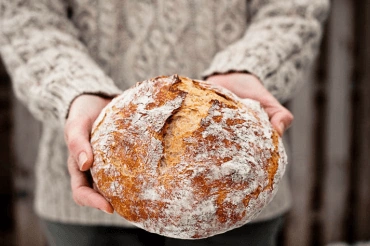16
And the feast of harvest, the firstfruits of thy labours, which thou hast sown in the field: and the feast of ingathering, which is in the end of the year, when thou hast gathered in thy labours out of the field.
16
And the feast of harvest, the firstfruits of thy labours, which thou hast sown in the field: and the feast of ingathering, which is in the end of the year, when thou hast gathered in thy labours out of the field.
By New Christian Bible Study Staff

The Children of Israel were told to keep three feasts each year - the feast of unleavened bread, the feast of first fruits, and the feast of ingathering. Should we still do that?
In Exodus 23:14-16, Moses receives the instructions about these feasts. Those three verses in Exodus comprise our brief story. Their inner meaning is explained in Arcana Coelestia 9286-9296.
There are three feasts. In the Word, the number three represents a completeness, a sense of things being covered from beginning to end. Our thankfulness to the Lord is supposed to keep going - to endure.
The first feast, of unleavened bread, stands for worship, for our thankfulness for the Lord's action in our minds to get rid of false ideas. That enables us to start to receive good loves.
The second feast, of first fruits, relates to the planting of true ideas in that "soil" of initial loves for doing good.
The third feast, of harvest, or ingathering, stands for the time when, by applying our true ideas, we receive real good - loves of the neighbor and of the Lord - that become the middle of our lives. This is the state of rebirth, where we have - by working through the year (our lives), and enduring in thankfulness, allowed the Lord to get rid of our false ideas, and push our evil loves to the periphery, so that good can work, and be fruitful.
These feasts, then, represent the progress of our spiritual lives. In some manner, we need to keep them.
2021. 'For an eternal covenant' means conjunction with these people. This is clear from the meaning of 'a covenant' as conjunction, dealt with already in 665, 666, 1023, 1038; and that this conjunction is with those called 'the seed' is clear from the fact of its coming immediately after a reference to that 'seed', and of its being a second mention in this verse of a covenant. Thus the first mention of 'a covenant' has reference to the union of Jehovah with the Human Essence, and the second to the conjunction with those who are 'the seed'. To allow a clearer idea of the union of the Lord's Divine Essence with the Human Essence and of the conjunction of the Lord with the human race by means of the faith that inheres in charity, let the term union here and from now on be used to describe the first of these, and conjunction the second. Indeed the bond between the Lord's Divine Essence and Human Essence really was a union, but that between the Lord and the human race by means of the faith that inheres in charity is conjunction. From this it is clear that because Jehovah or the Lord is Life, His Human Essence became Life as well, as shown above. It was a union of life with life. Man however is not life but a recipient of life, as also shown already. When life flows into a recipient of life conjunction takes place, for life accommodates itself to the recipient as active does to passive or as that which in itself is living does to that which in itself is dead but made living from that which in itself is living. In the case of the principal and the instrumental, as they are called, they do indeed seem to have been joined together to exist as one. Nevertheless they are not one, for each exists by itself. Man does not live of himself, but the Lord in His mercy links him to Himself and in so doing causes him to live for ever. And because the Lord and man are distinct and separate from each other the term conjunction is used.